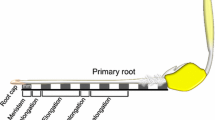Abstract
We studied changes in gene expression during the establishment of vesicular-arbuscular (VA) mycorrhizal symbiosis. Polypeptides were obtained by in vitro translation of total root RNA extracted from VA-colonized and noncolonized root-tissue of onion (Allium cepa L. cv. Babosa), and resolved by two-dimensional polyacrylamide gel electrophoresis. VA mycorrhization led to a specific appearance of eight new polypeptides, and the disappearance of seven polypeptides in VA-colonized root. Our findings indicate that gene expression is altered in response to morphological and physiological changes resulting from the establishment of VA mycorrhizas.
Similar content being viewed by others
References
Anderson A (1988) Mycorrhizae host specificity and recognition. Am Phytopathol Soc 78:375–378
Bonfante-Fasolo P (1984) Anatomy and morphology of VA mycorrhizae. In: Powell CLL, Bagyaraj DJ (eds) VA mycorrhizae. CRC Press, Boca Raton, Fla, pp 5–33
Cathala G, Savouret JF, Mendez B, West BL, Karin M, Martial JA, Baxter JD (1983) A method for isolation of intact, translationally active ribonucleic acid. DNA 2:335–339
García-Romera I, Ocampo JA (1988) Effect of the herbicide MCPA on VA mycorrhizal infection and growth of Pisum sativum. Z Pflanzenernähr Bodenkd 151:225–228
Giovannetti M, Mosse B (1980) An evaluation of techniques for measuring vesicular-arbuscular mycorrhizal infection in roots. New Phytol 84:489–500
Gloudemans T, Bhuvaneswari TV, Moerman M, Van Brussel T, Van Kammen A, Bisseling T (1989) Involvement of Rhizobium leguminosarum nodulation genes in gene expression in pea root hair. Plant Mol Biol 12:157–167
Harley JL, Smith SE (1983) Mycorrhizal symbiosis. Academic Press, New York
Hewitt EJ (1952) Sand water culture methods used in the study of plant nutrition. Commun Agric Bur Techn Commun, no 22
Hubert JL, Martin F (1988) Regulation of gene expression in ectomycorrhizas. I. Protein changes and the presence of ectomycorrhiza-specific polypeptides in the Pisolithus-Eucalyptus symbiosis. New Phytol 110:339–346
Lullien V, Barker DG, De Lajudie P, Huguest T (1987) Plant gene expression in effective and infective root nodules of alfalfa (Medicago sativa). Plant Mol Biol 9:409–478
MacDonald RM (1981) Routine production of axenic vesicular-arbuscular mycorrhizas. New Phytol 89:87–93
O'Farrel PH (1975) High resolution two dimensional electrophoresis of proteins. J Biol Chem 250:4007–4021
Phillips JM, Hayman DS (1970) Improved procedures for clearing roots and staining parasitic and vesicular-arbuscular mycorrhizal fungi for rapid assessment of infection. Trans Br Mycol Soc 55:158–161
Wyss P, Mellor RB, Wiemken A (1990) Vesicular-arbuscular mycorrhizas of wild-type soybean and non-nodulating mutants with Glomus mosseae contain symbiosis-specific polypeptides (mycorrhizins), immunologically cross-reactive with nodulins. Planta 182:22–26
Author information
Authors and Affiliations
Rights and permissions
About this article
Cite this article
Garcia-Garrido, J.M., Toro, N. & Ocampo, J.A. Presence of specific polypeptides in onion roots colonized by Glomus mosseae. Mycorrhiza 2, 175–177 (1993). https://doi.org/10.1007/BF00210587
Issue Date:
DOI: https://doi.org/10.1007/BF00210587




